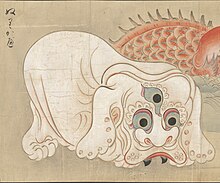Nurikabe

Thenurikabe(Đồ り vách tườngorĐồ vách tường[1]) is ayōkai,or spirit, fromJapanese folklore.Its name translates to "plaster wall", and it is said to manifest as an invisible wall that impedes or misdirects travelers walking at night.[2]Sometimes referred to in English as "The Wall" or "Mr. Wall", thisyōkaiis described as quite tall, to prevent people from climbing over it, and wide enough to dampen any attempts to go around it.[1]Japanese scholar and folkloristKunio Yanagitarecorded perhaps the most prominent early example ofnurikabeand otheryōkaiin his books.[2]Manga artistShigeru Mizukiclaims to have encountered anurikabeinNew Guinea,inspiring anurikabecharacter in hismangaGegege no Kitarō.[2]
Mythology[edit]
Thenurikabetakes the form of a wall—usually invisible—that blocks the path of travelers as they're walking. With the exception ofMizuki Shigeru'sexperience in New Guinea, most legends and accounts ofnurikabecome fromKyūshū,in theŌitaandFukuokaprefectures.[2]Some iterations of the legend say that trying to go around the wall is futile as it extends forever. Others say that knocking on the bottom left part of the wall with a stick will make it disappear, but that knocking on the upper part of it will yield no result.[2][3]It has been suggested that the legend of thenurikabewas created to explain travelers losing their bearings on long journeys.[4]Somenurikabe-like experiences that have been recorded have been attributed as the doing oftanuki,known astanuki no nurikabe.These happenings, instead of involving a wall, are instances where the traveler suddenly cannot see in front of themselves.[2]
In popular culture[edit]
Thenurikabehas been explicitly referenced in several forms of pop culture. There is anurikabecharacter named Nurikabe inShigeru Mizuki's manga seriesGegege no Kitarō.The character's main function is to be a shield in order to protect other members of the Kitarō family. Mizuki attributes much of his inspiration for the series to an experience he had with anurikabein New Guinea[5]duringWorld War II,as well as to the writings ofKunio Yanagita.[2][6]Mizuki's illustration for thenurikabegave it a more physical and anthropomorphic form with arms and legs, rather than the more traditional invisible wall concept.[6]TheMariofranchise featuresnurikabeenemies called Whomps, which first appeared inSuper Mario 64.
References[edit]
- ^abHiroko., Yoda; y điền khoan tử. (2012).Yokai attack: the japanese monster survival guide.Alt, Matt., マット・アルト. (Rev. ed.). Rutland, Vt.: Tuttle Pub.ISBN978-1462908837.OCLC856525665.
- ^abcdefgFoster, Michael Dylan (2015-01-14).The book of yōkai: mysterious creatures of Japanese folklore.Berkeley.ISBN978-0520959125.OCLC893735854.
{{cite book}}:CS1 maint: location missing publisher (link) - ^THE Nhật Bản Visual Human Life. Giảng nói xã. 1986: 759.ISBN4-06-202038-6
- ^"Nurikabe".The Element Encyclopedia of the Psychic World.Vol. 1. Harper Element. 2006. p. 491.
- ^Shamoon, Deborah (October 2013)."The yokai in the database: supernatural creatures and folklore in manga and anime".Marvels & Tales.27(2): 276+.doi:10.13110/marvelstales.27.2.0276.S2CID161932208.
- ^abFoster, Michael Dylan (2009).Pandemonium and parade: Japanese monsters and the culture of yōkai.Berkeley, Calif.ISBN978-0520253629.OCLC808601074.
{{cite book}}:CS1 maint: location missing publisher (link)
Bibliography[edit]
- Yêu quái ドットコム 『 đồ nói yêu quái từ điển 』 huyễn đông xá コミックス, 2008 năm.ISBN978-4-344-81486-8.
